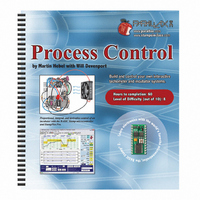122-28176 Parallax Inc, 122-28176 Datasheet - Page 284

122-28176
Manufacturer Part Number
122-28176
Description
GUIDE STUDENT PROCESS CONTROL
Manufacturer
Parallax Inc
Specifications of 122-28176
Accessory Type
Manual
Product
Microcontroller Accessories
Lead Free Status / RoHS Status
Contains lead / RoHS non-compliant
For Use With/related Products
Propeller Education (PE) Kit
Lead Free Status / RoHS Status
Lead free / RoHS Compliant, Contains lead / RoHS non-compliant
- Current page: 284 of 330
- Download datasheet (11Mb)
Page 274 · Process Control
ACTIVITY #2: BIAS AND SYSTEM RESPONSE
Activity #1 was good to demonstrate the PID evaluations of a system, but it is not
representative of the response of a closed-loop system. There was no electro-mechanical
system in place to control the light level based on the PID evaluations. Consider though
if we had a servo connected to blinds. As the light level increased, the servo would
position the blinds in an attempt to maintain light level at the setpoint, perhaps in growing
some rare plant that required a certain amount of light to flourish.
The standard hobby servo sold by Parallax requires values from the BS2 from 500 to
1000 for control. Sending the servo a pulse width value between 500 and 1000, the servo
is controlled to a position between roughly 0 and 90 degrees. If the servo was coupled to
a light shade, the shades could be adjusted to be fully open or fully closed. Biasing
would be set so that the light level coming through the blinds was at a medium level
under normal conditions (midday sun).
Now consider the value of light error in our experiments. An error of 200, 500 or a 1000
in some cases was very likely. If it got lighter outside (early morning sun shining
through), the error and thus the control output would result in the servo adjusting the
blinds to shut some. Conversely, darkening (cloudy day) would cause the blinds to open
some.
Our output was hundreds or thousands, positive and negative. The servo requires a range
of 500 to 1000 for full control. There is a disparity in the values we output and the values
needed for actual control. Of course, with a little math we can span and offset the output
value to match the controls input value. But it is much easier to discuss systems in terms
of percentage so that no matter the ranges involved, the system is measuring, calculating,
and driving in the common units of percent.
Under normal conditions, the servo will be controlled over a range of 0% for fully open
to 100% fully closed. The light level will be from 0% for darkest to 100% for lightest.
Under normal condition, the desired light level of 50% is achieved when the servo is
driven at 50%. If the light level increases, say 10%, the servo will have its output
increased by 10% to darken the area. If the light level reaches 100%, the servo will be at
100% to be fully closed.
We begin discussing the entire system in terms of percentages, and it makes it much
easier to discuss in generalities and in actual system response. %Error, %Total Drive,
Related parts for 122-28176
Image
Part Number
Description
Manufacturer
Datasheet
Request
R

Part Number:
Description:
MANUAL FOR SUMOBOT
Manufacturer:
Parallax Inc
Datasheet:

Part Number:
Description:
GUIDE STUDENT SMART SENSORS
Manufacturer:
Parallax Inc
Datasheet:

Part Number:
Description:
MANUAL PROPELLER
Manufacturer:
Parallax Inc
Datasheet:

Part Number:
Description:
LEAD WIRES FLYING CABLE III/IV
Manufacturer:
Xilinx Inc
Datasheet:

Part Number:
Description:
BOARD ADAPTER AND FLY LEADS
Manufacturer:
Xilinx Inc
Datasheet:

Part Number:
Description:
PLATFORM CABLE USB II
Manufacturer:
Xilinx Inc
Datasheet:

Part Number:
Description:
KIT STARTER COOLRUNNER-II BUNDLE
Manufacturer:
Xilinx Inc
Datasheet:

Part Number:
Description:
Microcontroller Modules & Accessories DISCONTINUED BY PARALLAX
Manufacturer:
Parallax Inc

Part Number:
Description:
Microcontroller Modules & Accessories DISCONTINUED BY PARALLAX
Manufacturer:
Parallax Inc

Part Number:
Description:
BOOK UNDERSTANDING SIGNALS
Manufacturer:
Parallax Inc
Datasheet:

Part Number:
Description:
BOARD EXPERIMENT+LCD NX-1000
Manufacturer:
Parallax Inc
Datasheet:

Part Number:
Description:
IC MCU 2K FLASH 50MHZ SO-18
Manufacturer:
Parallax Inc
Datasheet:












